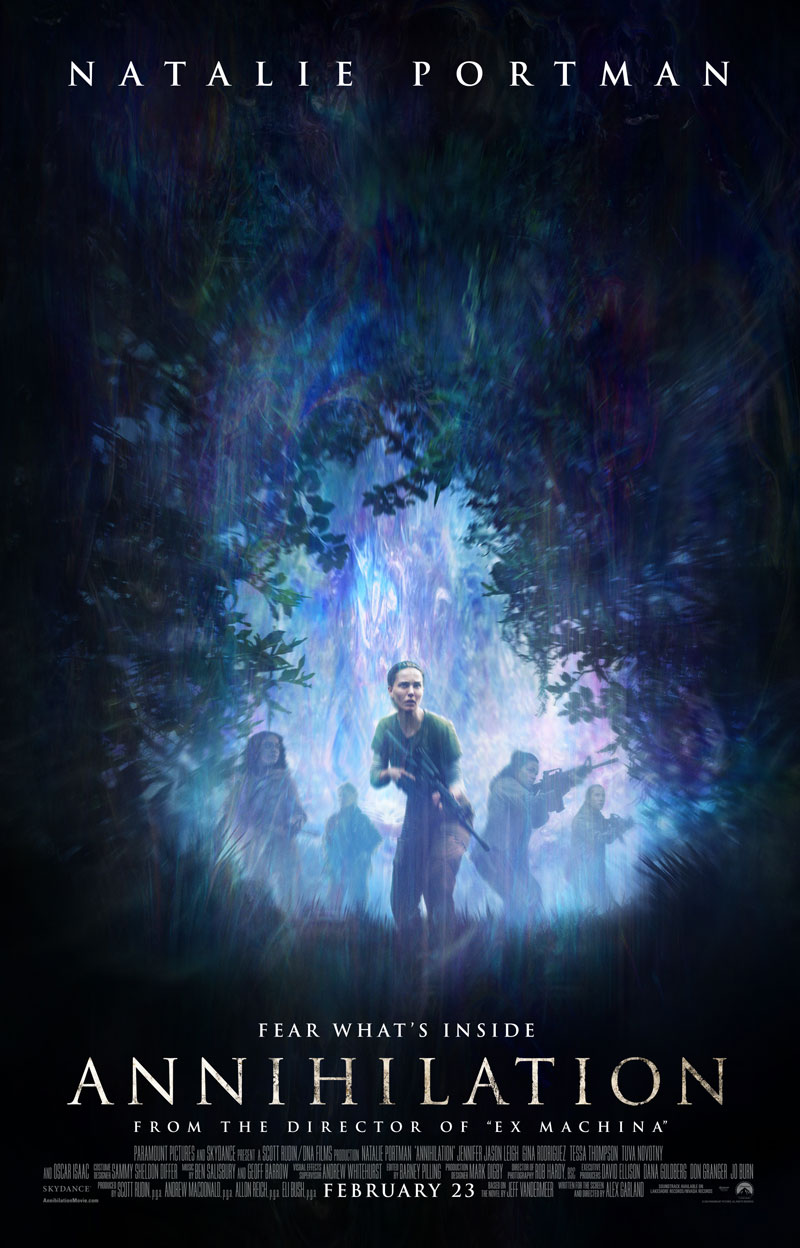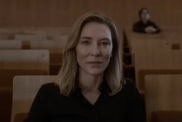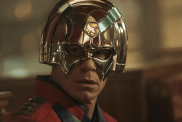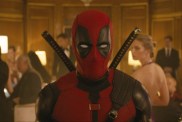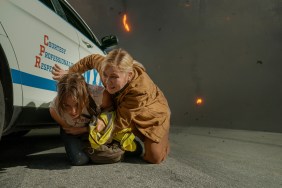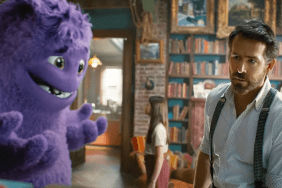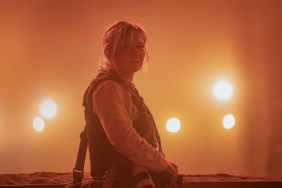The house is covered in ivy.
It’s not a real classic two-story Victorian and it’s not real ivy, but if you squint and ignore the roof and walls of Soundstage F at Pinewood Studios where it’s been built, you might think it’s the real thing. From the smell of the floorboards to the paint chips and water stains on the walls, it feels real, a testament to the work of the crew who have built it and the other sets for Paramount’s Annihilation, the newest sci-fi mind bender from Alex Garland, the Academy Award-nominated writer-director of Ex Machina.
RELATED: Watch the New Trailer for Alex Garland’s Annihilation
Clearly the people working on the film feel pride in what they’ve created, and that they’ve created it in the here and now, as they keep comparing the work to their neighbor. The small corner of the Pinewood complex Annihilation occupies is the only part of the studio not being used to shoot Star Wars: The Last Jedi. The David-Goliath feel between the very different sci-fi films is noted regularly, particularly the differing aesthetics.
“You walk past the Star Wars sets, it’s just a sea of green screen,” unit publicist Sarah Clark mentions. It does, however, make it possible for Oscar Isaac — Star Wars’ Poe Dameron — to quickly make his way from those stages to the Annihilation sets where he plays David, husband of Natalie Portman’s Dr. Lena Kerans and the individual who sets Annihilation’s story in motion. What that story is, though, is a bit harder to describe. Though Annihilation is obsessed with being realistic, it does not at all care for the real.
Something has arrived on Earth, placing a portion of the American southeast under an effect called The Shimmer, which renders electronics inoperable, distorts perceptions of time and space and gradually de- and re-composes animal and plant life within it. Portman, leading a team of scientists including Jennifer Jason Leigh, Jane the Virgin’s Gina Rodriguez and Thor: Ragnarok’s Tessa Thompson, is traveling through it searching for its cause. In the process they’ll have to survive encounters not just with the mutated life within but with their own distorted memories and senses and gradually failing sense of self.
Or as Garland puts it: “It’s a trip.”
To make it a reality, he has brought back many of his Ex Machina colleagues, including producer Andrew Macdonald, cinematographer Rob Hardy and production designer Mark Digby. But while much of the aesthetic of that film is familiar in Annihilation (insofar as the set-up allows for it), Garland has taken the source material — based on the novel by Jeff VanderMeer — as a stepping stone to very different questions about the nature of consciousness and reality and how they do and do not connect with one another.
More than its psychedelic nature, however, Garland won’t commit to.
“Probably, in the days of ’28 Days Later’ or ‘Sunshine’ I might have tried to express what things were, but I’ve stopped doing that. There isn’t really any point that should be described. The thing has got its own feelings and it’s trying to present them… [but] it doesn’t really matter,” he says, because people will view a text or film their own way. “It’s not something our language, let alone a sort of narrative is even capable of doing. You’ll hit proportions of people, and other proportions of people will literally see 180 degree opposite of whatever the intention was. And you saying, ‘well that was the intention’ doesn’t change it.”
Within the house, Natalie Portman is tied to a chair.
She’s not alone; Leigh and Rodriguez are tied up with her. One of their colleagues has gone mad; the sensory deprivation of The Shimmer heightens paranoia, and is testing them when a bear arrives. The camera slinks past the three women (Annihilation is a notably woman-driven film with the four scientists being the only characters on screen much of the time) to reveal the bear in the doorway behind them, before it approaches and starts to sniff them while they desperately contain their fear.

Except it’s not a bear, in every sense of the phrase. All props to Portman, Leigh and Rodriguez’s acting chops. The terror on their faces and in their body language is so enthralling, you completely ignore Garland walking around them carrying a puppet bear head. The actual bear will be computer generated later – partly because no one is going to let a real bear snuffle an Oscar-winning actress, but partly because no bear ever looked like this.
Mark Digby’s production office is filled with pictures of the bear: grotesque and decayed, its face seems to be melting from its body, even as other faces — of human beings — appear to be gaping from its side like exposed sores. The idea, as Digby explains, is that when it eats someone or something, it absorbs them into self and can then later even speak with that character’s voice, stalking its prey with familiar sounds. It is hardly the weirdest thing on the walls in the Annihilation art department, but they do all have one thing in common.
“Even though we’re working in science fiction we try to keep everything grounded and real,” Digby says. “The natural environment is a starting point for us.”
A row of trees reveals itself to be people transformed into plant life, frozen as screaming topiary. A man on chair in a drained pool has been turned into crystal, dismembered and implanted into the cement of the wall, his head and legs the only clue as to what he was.
The largest amount of mood boards are relegated to The Shimmer itself as the art (and later visual effects) department tries to figure out what that will look like. A final decision still hasn’t been made (and likely won’t be until well into post-production), but what has emerged is the idea of refracting light like a prism.
“It’s very much refraction and mutation and the look is about what it’s doing to the things within The Shimmer,” Digby says.
Like Garland said, a trip. And yet the high-level weirdness factor is not the hardest part of the job for the production department.
“The challenge is we’re making it in England and it’s set in America,” Digby explains.
And though they did think about shooting in America, they ultimately didn’t because “we’ve made movies in England before and we know how,” Macdonald says. “If you can make a film with all of your locations really close together, it’s really useful. Making it in a lot of different countries, all spread far apart… it’s really, really difficult.”
We’re sitting in the lunch room at Pinewood, all wood paneling and arches like something from an Elizabethan manor house with garden to match outside. To get there you have to walk past Harrison’s Ford’s costume from The Empire Strikes Back and Freddie Young’s cinematography Oscars for Lawrence of Arabia and Doctor Zhivago. Everything about Pinewood screams ‘film history’ – you even have to walk down Goldfinger Avenue to get to the stages Annihilation has taken over.
None of it, however, particularly cries rural Louisiana, which makes Digby and the crew’s feat of recreating the Bayou so remarkable.
Much of the teams’ journey is through a wet marshland, by foot and canoe, culminating the astounding visual of a partially-sunken mobile home where they are attacked by an alligator. Pictures of the actual shoot (which took place some weeks prior) look so much like a Louisiana swamp it’s easy to forget they were filmed just down the road in the same park where Windsor Castle sits.
“It’s not that far, it’s 20 minutes,” Allon Holland, one of the film’s other producers, explains.

“I always understood Windsor Park to be a castle and the stuff around it which is maybe a tenth of the actual park. The first thing we were shown was this overgrown pond which felt really secluded, like it could be anywhere – really exotic, lot of moss everywhere. People who visited us there, particularly Americans, could not believe we were five miles from Trafalgar Square. It’s jungly, exotic, dangerous somehow,” and very reminiscent of Apocalypse Now, he adds.
Apocalypse Now gets mentioned a lot.
“I think one of the things with ‘Apocalypse Now’ and indeed ‘Heart of Darkness,’ the documentary about it, is that you’re in ostensibly-beautiful, exotic-like places, with people going up where they accept for everything that nature is. And obviously in that film, more overtly, you know, there’s a human enemy trying to stop you. But also, somehow nature is very oppressive and feels very dangerous. And you’re also trying to get somewhere and you’re unraveling,” Holland says.
At the end of Digby’s mood boards is a selection of lighthouses on beaches – Portman’s ultimate destination. The top of the lighthouse, and its interior, is still being constructed on the stage next door to the dilapidated house. Every time filming stops, the sound of hammers and saws picks back up again as the construction crew races to stay ahead of the shooting unit (this is very typical of film sets where time is always the greatest enemy).
Annihilation is more than halfway through filming – it has been shot largely in continuity (“I think every filmmaker would like to shoot in continuity, you don’t always have that luxury. I think in this case the forward momentum of the story made it necessary,” Macdonald says) – and is rapidly approaching the moment when Portman and team reach the lighthouse.
While Annihilation the book was the first part of a trilogy dealing with the strange phenomenon Lena and her compatriots were investigating, much of that was not written when work on Annihilation the movie began, leaving the film very much its own beast.
“When I wrote this, I knew that there was going to be a trilogy, but I hadn’t read the other two books. They weren’t written. And so, I saw this as a contained thing, because I tend to think of stories as being contained things, not requiring further stories,” Garland says. “I’ve worked on some very faithful adaptations that are almost like holding a mirror up to the book. Like ‘Never Let Me Go,’ I adapted a few years ago, was really a very faithful adaptation. And then, I did another adaptation of a British comic book, ‘Dredd.’ It was very faithful to a character, but less faithful to a world, perhaps… this is probably more free form. It’s a very dream-like novel, a really beautiful novel, and it worked very well for my purposes. I loved what Jeff [VanderMeer] had done and we discussed it quite a lot. We’d have very long, I guess two, three-hour phone conversations that nearly bankrupted me, because he lives in America.“
The lighthouse interior is mostly completed, highly organic with a blown-glass and obsidian texture – very Alien-esque. What they find there… well Garland and Co. won’t say, so neither can we beyond the thought that technically and thematically Annihilation may be the most ambitious work Garland and his associates have yet attempted.
“It has its own questions that it poses. The questions, the fundamental questions that it poses, it does answer. Sorry. I’m not trying to being elliptical, but it does,” Garland does say.
Paramount Pictures will release Annihilation in theaters on February 23, 2018.
Annihilation
-
ANNIHILATION

Left to right: Natalie Portman and Oscar Isaac in ANNIHILATION, from Paramount Pictures and Skydance. -
ANNIHILATION

Alex Garland and Jeff VanderMeer on the set of Annihilation from Paramount Pictures and Skydance. -
ANNIHILATION

Gina Rodriguez, Natalie Portman, Tessa Thompson and Tuva Novotny in Annihilation from Paramount Pictures and Skydance. -
ANNIHILATION

DIrector Alex Garland and Natalie Portman on the set of Annihilation from Paramount Pictures and Skydance. -
ANNIHILATION

Tess Thompson and Gina Rodriguez in Annihilation from Paramount Pictures and Skydance. -
ANNIHILATION

Gina Rodriguez in Annihilation from Paramount Pictures and Skydance. -
ANNIHILATION

Natalie Portman and Gina Rodriguez in Annihilation from Paramount Pictures and Skydance. -
ANNIHILATION

Natalie Portman in Annihilation from Paramount Pictures and Skydance. -
ANNIHILATION
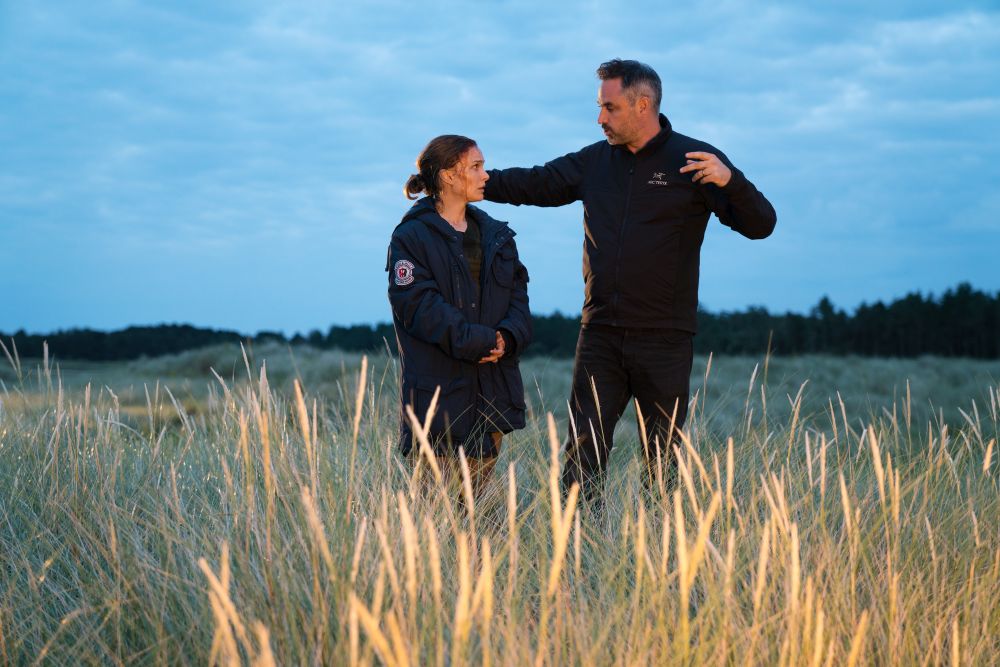
Natalie Portman and Director Alex Garland on the set of Annihilation from Paramount Pictures and Skydance. -
ANNIHILATION

Jennifer Jason Leigh plays Dr. Ventress in Annihilation from Paramount Pictures and Skydance. -
ANNIHILATION

Tuva Novotny plays Cass Sheppard, Gina Rodriguez plays Anya Thorensen, Tessa Thompson plays Josie Radek and Natalie Portman plays Lena in Annihilation from Paramount Pictures and Skydance. -
ANNIHILATION

Oscar Isaac in Annihilation from Paramount Pictures and Skydance. -
ANNIHILATION

Natalie Portman plays Lena and Tuva Novotny plays Cass Sheppard in Annihilation from Paramount Pictures and Skydance. -
ANNIHILATION

Natalie Portman plays Lena in Annihilation from Paramount Pictures and Skydance. -
ANNIHILATION

Tessa Thompson plays Josie Radek in Annihilation from Paramount Pictures and Skydance. -
ANNIHILATION

Jennifer Jason Leigh and Natalie Portman in Annihilation from Paramount Pictures and Skydance. -
Annihilation

-
Annihilation

-
Annihilation

-
Annihilation

-
Annihilation

-
Annihilation
